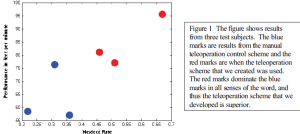Jacob W. Crandall and Dr. Michael A. Goodrich, Computer Science
Over the last few years, there have been vast advancements in robot technology. These advancements have made robots more powerful. However, because of robot limitations, many interesting tasks will probably include humans and robots cooperating to achieve a shared goal. Lessons from process automation indicate that, in many instances, increased machine automation can actually decreased the effectiveness of human operators. This lesson tells robot designers that robots must be designed with human factors in mind. Situations arise where “artificial intelligence” isn’t sufficient and human reasoning can significantly improve performance.
With this in mind we have designed a human-robot system in which many robots can connect to a central interface. The interface gathers information from the robots and displays it in a readable form to the human operator. A “god’s eye” view of the world shows where each robot is and where it has been. Additionally, the interface provides the operator with the opportunity to control one of the robots at a time more directly. All of this robot’s sensor information (video image, sonar ring, and compass) is displayed visually.
The interface also allows the operator to give commands to each robot individually. Each of the robots has the capability to operate in various control schemes. Through the interface the operator can select one of these control schemes for each robot and then issues various commands by dropping goals on the “god’s eye” map of the world or sending input to the robot through a joystick. This gives the human the capability to interact with the robots.
Central to the human robot system we have designed is the principle of adjustable autonomy. Adjustable autonomy means that the robot has the ability to operate at various autonomy levels. We have selected five autonomy levels or control schemes. They are (in increasing levels of autonomy): teleoperation (in which the robot is controlled via a joystick), extended teleautonomy (in which the operator gives the robot waypoints and heuristics it must reach), teleautonomy (in which the operator gives the robot a goal location, and the robot must move to it), and autonomous (in with the operator gives little or no input; the robot acts on its own).
The basic idea is that a robot requires less attention from the human operator as the robot becomes more autonomous. However, the robot is generally more effective the more attention it receives from the operator. Since there exists this tradeoff between neglect rates and robot effectiveness, two things become important to a human-robot system: 1) We must establish how much neglect is permissible to obtain a certain level of robot effectiveness and 2) We desire to design robot control schemes that increase the amount of permissible neglect to obtain a desired robot effectiveness.
To begin with we have worked on the teleoperation control scheme. Traditional teleoperation calls for pure manual control. However, so as to improve the control scheme, we implemented a teleoperation algorithm that gives control to the operator but also allows the robot to make detailed decisions in the process, thus decreasing the demand on the operator. The overall algorithm is too long to describe in this paper, but it will appear in (1). In general, we use a utilitarian voting scheme involving the joystick signal sent to the robot and the sonar readings on the robot to obtain the direction that the robot should go at a given moment.
To ensure that this teleoperation scheme does, in reality, improve permissible neglect rate, we designed an experiment in which subjects drive the robot using both manual control teleoperation and the teleoperation scheme that we designed. The subjects were asks to drive the robot around the third floor of the Talmage Building. Subjects where asked which control scheme was better. Additionally, so as to classify acceptable neglect rates and robot effectiveness, subjects where asked to do a secondary task as they drove the robot around the building. The secondary task that we selected was to have the subjects perform simply arithmetic problems as they drove the robot around. Subjects were told to try to get the robot around the building as quickly as they could, as well as answer as many arithmetic problems correctly as was possible.
Subjectively, the experiment participants indicated that they felt that our teleoperation control scheme was better in that it was easier and more effective. These subjective results followed the objective results we have obtained from the experiment. Some of these results are shown in figure 1. The red dots indicate results when subjects where driving the robot with our teleoperation control scheme and the blue dots are the results of the manual teleoperation control scheme. The horizontal access shows neglect rate. The higher the neglect rate (or the more time the subjects spent answering arithmetic problems rather than focusing on the robot) the higher the neglect rate. The vertical axis shows how fast the robot went around the building, faster times indicating better performance. As can be seen from the figure, the teleoperation scheme that we devised dominates in all senses of the word the manual teleoperation control scheme.
Human-robot systems will perform better in the future as improved control schemes are implemented. We feel that we were successful in demonstrating this through our research.
References
- J. W. Crandall and M. A. Goodrich. Experiments in Adjustable Autonomy. In Proceedings of Systems, Man, and Cybernetics, October 2001. To appear.

